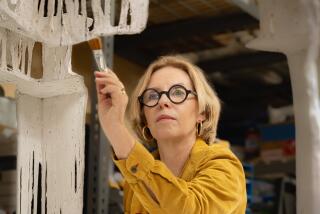Aaron Kramer’s salvaged whimsy
When Aaron Kramer was a boy, he would ride his bike through the streets of his Chicago neighborhood on the evening before trash pickup, trawling for interesting discards.
“Thursday night was my gold mine night as a kid,” he recalls. Settled in Santa Monica for the last dozen years, Kramer, 46, still keeps an eye out for underappreciated treasures, such as the wooden brooms he noticed poking out of garbage cans, their handles worn from repeated use. Whenever he saw one, he’d throw it in the back of his van, and after a while, he’d collected enough to create a headboard out of them.
Everyday objects with the patina of time and wear pack his studio and serve as the raw materials of his sculpture: chairs encrusted with used wine corks; hanging lamps woven from wooden coffee stirrers; small, wall-mounted boats pieced together from sections of wooden salad bowls; gourd-like vessels shaped from the slender metal bristles of a street sweeper. These and more make up the artist’s first solo museum show, “Salvaged: Aaron Kramer and the Secret Life of Objects,” at the Craft and Folk Art Museum through Sept. 12.
Now, he says, “Stuff kind of finds me. An object has to speak to me before I can use it in a piece, but also, given a thousand of something, I can probably figure something out.”
Tools and toys — discarded auto parts, bowling pins, metal washers, industrial strapping, stuffed animals, spinning tops and miniature trains — make frequent appearances in Kramer’s work, which melds the worlds of invention, design and play. Some of it is poignant and some purely whimsical. Humor is key to the process: “I do find that if a piece makes me laugh as I’m making it, I know I’m on to something.”
He credits the influence of Joseph Cornell, Martin Puryear and a host of interdisciplinary architects and designers. Alexander Calder also looks to be an inspiration, as well as the century-long tradition of found-object assemblage.
“Trash is the failure of imagination,” he claims as his motto. “I certainly believe it and live it.” He also teaches it, in workshops for children and adults, telling students, “There’s a distinct difference between trash and garbage. Trash is ooh, and garbage is eww. Trash is something that has a potential reuse.”
Kramer is certainly resourceful with materials, but he hopes viewers see the beauty and craftsmanship of the work first. “It’s like an extra bonus payout at the end when they find out it’s made of something they encounter every day.”
— Leah Ollman
More to Read
The biggest entertainment stories
Get our big stories about Hollywood, film, television, music, arts, culture and more right in your inbox as soon as they publish.
You may occasionally receive promotional content from the Los Angeles Times.






